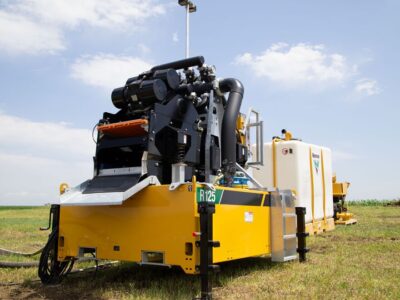With horizontal directional drilling (HDD) growing more competitive, effective utility drilling fluid management offers a significant competitive edge. A fluid management solution sized for utility installation minimizes the amount of water and additives required to drill. The advantages are two-fold, benefiting your operations and the environment.
How? Labor previously used to haul water and dispose of drilling fluid can be reallocated for drilling. Minimal fluid also lowers demand on vac systems and helps manage disposal costs. Plus, dumping water and drilling fluids additive mixture after only one use may not make sense from a cost or environmental standpoint.
Mud is the lifeblood of an HDD operation. That means rising fluid disposal costs and limited freshwater availability can negatively impact your per-foot (per-meter) installation rates. This creates a challenge for utility contractors, but reclaimers can help operations bridge the gap.
Help minimize environmental impact and operational costs
With larger drills — 100,000 lb (444.8 kN) thrust and above — reclaimers provide a means to manage drilling fluid that can significantly influence project costs. They minimize freshwater use and disposal expenses, but these reclaimers are often too big to fit on compact urban jobsites.
A reclaimer sized for the smaller crew on a utility job site could help offset higher drilling fluid disposal costs and increasingly competitive price-per-foot (price-per-meter) rates. By efficiently minimizing cuttings, rocks, sand and fine particles, this reclaimer enables the reutilization of clean fluids. This helps enhance resource sustainability and cost-effective drilling.
“If you can use reclaimers and retain 70% to 80% of the drilling fluid that is being pumped down the hole and reuse 90% to 100% of that recycled fluid, you’ve reduced those dumping costs dramatically,” said Marv Klein, solution specialist at Vermeer. “It is not just the dumping fees. You have transportation, you have fuel cost, you’re paying a truck driver to haul up and down the road back and forth from the jobsite to the disposal site.”
A drilling fluid management solution sized for utility
Vermeer has met the growing demand for a utility-sized reclaimer with the introduction of the R125 mud reclaimer. Specifically designed for the North American market, it operates on 480V at 60 Hz. This reclaimer is tailored to prioritize ease of operation and quick setup, allowing your crew to concentrate on the drilling task at hand. There’s no need to manually control valves. The level switches in the reclaimer tank and the remote level switch in the mixing tanks help prevent overflow through the fluid system setup and help reduce labor. It is designed as a skid for flexible transportation options with forks to help ease jobsite setup.
The R125 pairs with the MX300/MX300D mix systems and competitive mixers to support HDDs sized from the D24x40 S3 HDD through the D40x55 S3 HDD. The R125 features a 600-gal (2,271.2-L) water tank. When paired with the 1,000-gal (3,785. 4-L) tank option on the MX300, crews get a 1,600-gal (6,056.7-L) capacity.
Keep drilling fluid clean
Although capacity is a crucial factor, the cleanliness of the mud is equally vital when choosing a reclaimer for utility work to prolong pump life. The R125 achieves premium cleaning performance through six 4-in (10.2-cm) long-body hydrocyclones and a relatively large screen area. The primary screens are kept in place with an air-clamping system, powered by an onboard air compressor. This allows for ease of access and the ability to quickly change screens.
Recycling drilling fluid helps drive efficiency
A sufficient supply of drilling fluid is essential for HDD contractors to maintain operational efficiency. With growing competition in HDD pricing, a reclaimer used for utility work can offer contractors a strategic advantage. Recycling drilling fluid means crews spend less time and resources sourcing and disposing of the fluid needed for their work. That enhances efficiency.
Contact your local Vermeer dealer to discover the benefits of utility drilling fluid management.
Vermeer Manufacturing International Goes reserves the right to make changes in engineering, design and specifications; add improvements; or discontinue manufacturing at any time without notice or obligation. Equipment shown is for illustrative purposes only and may display optional accessories or components specific to their global region.Please contact your local Vermeer dealer for more information on machine specifications.
Vermeer and the Vermeer logo are trademarks of Vermeer Manufacturing Company in the U.S. and/or other countries.
© 2024 Vermeer Corporation. All Rights Reserved.

